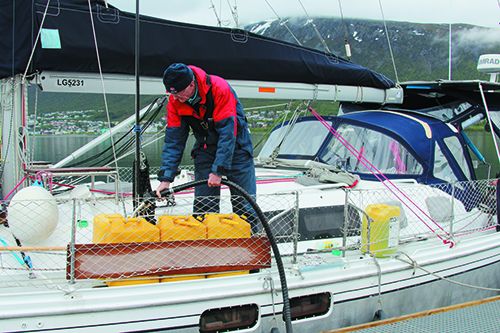
We’ve ensured that we’re taking on good, high quality fuel and we’re even pre-filtering it, yet still our filters clog quicker than they ever have. It’s enough to make us want to scream something a little more profane than “humbug!” — although that would be the most fitting epithet.
Typically, the crud that clogs our fuel filters is mostly microrganisms, primitive creatures that live in water and feed on oil. They’re informally called “HUM bugs.” The HUM stands for Hydrocarbon Utilizing Microorganisms.
There are many kinds of HUM-bugs—bacteria and fungus (mold, yeast, algae, etc.). The ones that need oxygen are aerobic bacteria; those that survive without oxygen are anaerobic; those that can handle either situation are facultative. They all create thick slime, which helps them stick to surfaces and protect themselves from attack. Many are airborne. Some thrive best in freshwater, some in salt. It’s unlikely that you can buy diesel fuel without getting some.
They have proper names like Klebsiella spp., Corynebacterium spp., Alcaligenes spp., Pseudomonas aeruginosa, and dozens of others.
How fast these creatures grow depends heavily on temperature, but also on the amount of water present and the chemical make-up (Ph) of the water. Experts have told us that in as little as a week they can foul the fuel enough to start collecting in the secondary filters. In a month, the gunk can clog a common filter. The bacteria create a slime mat, with bodies laced together and long tendrils that can be seen with the naked eye.
Most biocides don’t kill all the HUM bugs, nor do they clean the slime-covered tank walls. The biocides must be used continuously, which encourages an accumulation of crud and promotes corrosion.
The U.S. Environmental Protection Administration offers on the internet an expansive registry of hundreds of fuel additives—including, several made by the Bayer Corporation, the global chemical giant known to many for its baby aspirin. Practical Sailor tests most of the most popular marine diesel additives and have picked our favorites for keeping water out and combatting corrosion.
What can a boat owner do to avoid the HUM-bug plague? Keep water out. No water = No HUM-bugs. Probably, the most effective thing you can do to prevent bug buildup is to ensure your fuel cap is sealed tightly. The o-ring should be fuel resistant Nitrile (buna-N) and soft and pliable. Lubricate with o-ring grease or plain old petroleum jelly. Keep at least one spare.
Water can also enter through the fuel tanks daily vent breathing as the air pressure changes. A fuel vent filter using silica gel (required on all new gasoline boats) can also help keep fuel dry. We’ve tested the H2Out AVD, and that test, along with other research on the role of silica gel in removing fuel, was instrumental in the development of the the gel-carbon NSF Vetus dual-filter, which was introduced shortly after our testing. If you do install a vent filter, follow the engine-maker’s guidelines and make sure it will be easy to inspect and replace the filters.
Be careful where you buy fuel. The critters live in large numbers in the bottom of big storage tanks and fuel dock tanks that, being underground, produce lots of condensation. Keep your own tank as full as possible (to reduce condensation) and filter the fuel as it comes aboard. In our testing, Mr. Funnel lives up to its claims.
If the filler tube permits, it would help perhaps once a season to run a small hose down to the bottom of the tank, pump out a glassful, and let it settle to see if what’s down there is water or fuel oil. (Some tanks have spigots, but usually it’s impossible to reach them.) If you find water, especially dirty-looking water, keep pumping until you get clean, clear fuel.
Depending on how much you use your boat, drain and clean the tank every year or two. The more you use the boat, the less often you need to do this. Fuel left to sit gets bad. If bad fuel and clogged filters continue to be a problem, a fuel polishing system may be a good option.
For a complete guide to fuel additives and fuel system care and maintenance check out or ebook “Marine Fuel Additives.”







































After numerous attempts and considerable expense to purge fuel tank including polishing fuel I replaced the tanks. These tanks were 20 years old and the weld around the fill tube showed consi sign of rust (ss tanks). New tanks included inspection port to allow periodic inspection and power washing as needed. The best plan is to follow the ounce of prevention adage. What you see in the filters are the excrement of these little buggers. Night and day difference in engine performance.
There is no way that Darrell Nicholson looks that good after 45 years of sailing.
On another note, perhaps 45 years of sailing has made him look this young !!!!!
Agreed. I need some of his fuel polishing.
My Gmail can’t be sent to you, I want to join you have good information